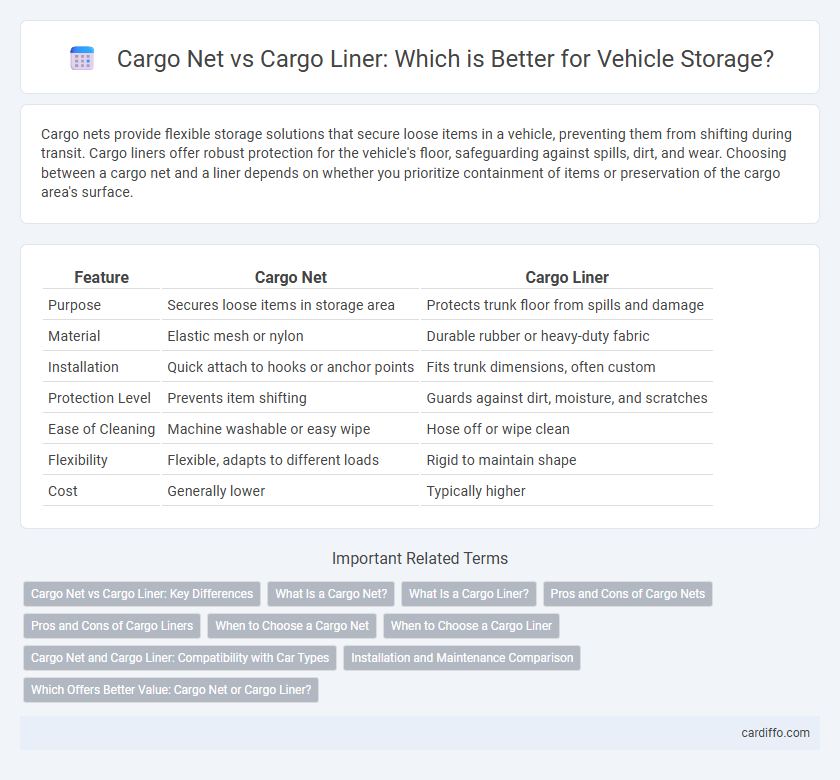Cargo nets provide flexible storage solutions that secure loose items in a vehicle, preventing them from shifting during transit. Cargo liners offer robust protection for the vehicle's floor, safeguarding against spills, dirt, and wear. Choosing between a cargo net and a liner depends on whether you prioritize containment of items or preservation of the cargo area's surface.
Table of Comparison
| Feature | Cargo Net | Cargo Liner |
|---|---|---|
| Purpose | Secures loose items in storage area | Protects trunk floor from spills and damage |
| Material | Elastic mesh or nylon | Durable rubber or heavy-duty fabric |
| Installation | Quick attach to hooks or anchor points | Fits trunk dimensions, often custom |
| Protection Level | Prevents item shifting | Guards against dirt, moisture, and scratches |
| Ease of Cleaning | Machine washable or easy wipe | Hose off or wipe clean |
| Flexibility | Flexible, adapts to different loads | Rigid to maintain shape |
| Cost | Generally lower | Typically higher |
Cargo Net vs Cargo Liner: Key Differences
Cargo nets provide flexible, stretchable storage solutions that secure loose items by preventing movement within storage compartments, ideal for varied shapes and sizes. Cargo liners offer rigid, protective coverage for floors and surfaces, guarding against spills, dirt, and wear in vehicle trunks or storage areas. The main differences lie in cargo nets enhancing item containment versatility, while cargo liners focus on surface protection and ease of cleaning.
What Is a Cargo Net?
A cargo net is a flexible storage accessory made from durable, interwoven straps designed to secure and organize items in vehicles, preventing them from shifting during transit. It is typically installed in the trunk or cargo area, providing a quick and adjustable solution to hold groceries, sports equipment, or loose gear. Unlike cargo liners, which protect surfaces, cargo nets focus specifically on containment and stability of transported goods.
What Is a Cargo Liner?
A cargo liner is a protective mat designed to cover the floor of a vehicle's cargo area, safeguarding it from dirt, spills, and damage during transportation. Made from durable materials like rubber, plastic, or carpet, cargo liners provide custom-fit coverage tailored to specific vehicle models. Unlike cargo nets that secure items in place, cargo liners primarily focus on protecting the cargo space surface from wear and tear.
Pros and Cons of Cargo Nets
Cargo nets provide flexible, lightweight storage solutions that secure irregularly shaped items and prevent shifting during transit, enhancing vehicle organization and safety. They are easy to install and remove but may lack the full coverage and spill containment offered by cargo liners, making them less effective for protecting vehicle interiors from dirt and liquids. Cargo nets excel in versatility and ventilation but offer limited protection against moisture and debris compared to cargo liners.
Pros and Cons of Cargo Liners
Cargo liners offer superior protection by shielding the vehicle's cargo area from spills, dirt, and wear, making them ideal for heavy-duty use and pet owners. Their custom-fit design provides comprehensive coverage, preventing damage to upholstery and easing cleanup compared to generic cargo nets. However, cargo liners can be less versatile than cargo nets, as they may limit cargo space flexibility and often require more maintenance to keep clean.
When to Choose a Cargo Net
Choose a cargo net when you need flexible and adjustable storage solutions for uneven or bulky items that require secure containment without restricting visibility. Cargo nets are ideal for vehicle trunks or truck beds where quick access and easy installation are essential. Opting for a cargo net provides ventilation and prevents items from shifting during transport, unlike rigid cargo liners that offer fixed coverage and protection.
When to Choose a Cargo Liner
Choose a cargo liner when you need comprehensive protection for your vehicle's cargo area from spills, dirt, and heavy wear, as it covers the entire floor surface with durable, water-resistant material. Cargo liners are ideal for transporting pets, gardening supplies, or equipment that might damage or stain the interior. They offer superior coverage compared to cargo nets, which primarily secure loose items but do not protect the cargo floor from damage or debris.
Cargo Net and Cargo Liner: Compatibility with Car Types
Cargo nets typically offer universal compatibility with various car models due to their adjustable straps and flexible mesh, making them suitable for irregularly shaped cargo areas. Cargo liners are often custom-fitted to specific vehicle makes and models, providing precise coverage and protection for the trunk floor and sides. Selecting between a cargo net and cargo liner depends on whether you prioritize adaptable storage solutions or tailored interior protection for your car.
Installation and Maintenance Comparison
Cargo nets require minimal installation, often attaching with hooks or straps to anchor points, making them quick and easy to set up. Cargo liners usually need precise placement to cover the vehicle floor, some models fitting custom dimensions that may require repositioning or trimming. Maintenance of cargo nets involves occasional cleaning and inspection for stretched or broken cords, while cargo liners demand more frequent cleaning to remove spills and debris and should be checked regularly for cracks or wear to ensure durability.
Which Offers Better Value: Cargo Net or Cargo Liner?
Cargo liners provide superior protection against spills, dirt, and wear by covering the entire trunk area with durable, water-resistant materials, making them ideal for frequent, heavy-duty use. Cargo nets offer flexible containment, preventing items from shifting during transit but lack full-surface protection, making them better suited for light cargo organization. Considering longevity, maintenance, and comprehensive coverage, cargo liners generally offer better value for those seeking maximum storage protection.
cargo net vs cargo liner Infographic

 cardiffo.com
cardiffo.com